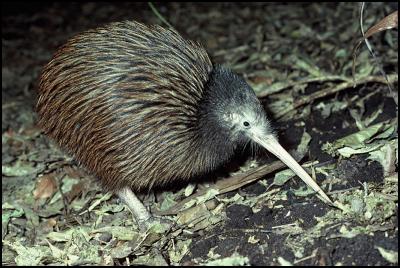Major project will help kiwi thrive
Tuesday 6 September 2005
Major project will
help kiwi thrive in Bay of Plenty

A major project launched this week by Environment Bay of Plenty and the Department of Conservation should ensure the survival of kiwi in the Bay of Plenty.
The two agencies yesterday committed to a partnership that aims to grow a small kiwi population near Whakatane to 200 over the next 10 years. It will involve the community in a project of national significance, says Environment Bay of Plenty chief executive Jeff Jones. “Kiwi are our nation’s treasures, yet they are in rapid decline in New Zealand. It’s the same in the Bay of Plenty. In much of the region, they are close to being virtually extinct.”
At an official ceremony yesterday (Monday 5 September) Henry Weston, the Department of Conservation’s regional conservator, described the partnership signing of the memorandum as “a tremendous occasion”. “It is unique to have such a committed and long-term Department of Conservation and regional council relationship,” he says, “With our organisations and the community working together we can significantly improve the situation of kiwi in the Bay of Plenty.”
Five years ago, only four pairs of kiwi lived in the Ohope Scenic Reserve, behind the township of Whakatane. Supported by funding from Environment Bay of Plenty’s Environmental Enhancement Fund for pest control, the Department of Conservation has grown that number to 19. Another six chicks were taken to Moutohora (Whale Island) to start a back-up colony.
The new 10-year joint kiwi management plan means the mainland project will expand to cover a core management area of 1430ha, which includes private land. Environment Bay of Plenty and the Department of Conservation’s key partners in the project include Ngati Awa, private landowners, the BNZ Recovery Trust, the Whakatane Kiwi Trust, Forest and Bird Protection Society and Whakatane District Council.
The population of the North Island brown kiwi halves every decade. When left to fend for themselves, only 10% of kiwi chicks survive stoats and other predators, including domestic cats and dogs. The regional council’s manager of land resources, Tony Hall, says the vision is for kiwi to prosper in the Whakatane district. “We want people to hear them at night in town and we want them to be visitors to suburban backyards,” he says.
ENDS


 Oji Fibre Solutions: OjiFS Proposes To Discontinue Paper Production At Kinleith Mill
Oji Fibre Solutions: OjiFS Proposes To Discontinue Paper Production At Kinleith Mill Hugh Grant: Navigating Digital Adoption In New Zealand - Embracing Change For A Bright Future
Hugh Grant: Navigating Digital Adoption In New Zealand - Embracing Change For A Bright Future Dawn Aerospace: Historic Flight - Breaks Sound Barrier And Global Records
Dawn Aerospace: Historic Flight - Breaks Sound Barrier And Global Records SEEK: SEEK NZ Employment Report - October
SEEK: SEEK NZ Employment Report - October University of Auckland: Protecting Young Minds With AI
University of Auckland: Protecting Young Minds With AI Greenpeace: Greenpeace Calls On Fonterra Investors To Consider Big Picture With Giant Puzzle
Greenpeace: Greenpeace Calls On Fonterra Investors To Consider Big Picture With Giant Puzzle



